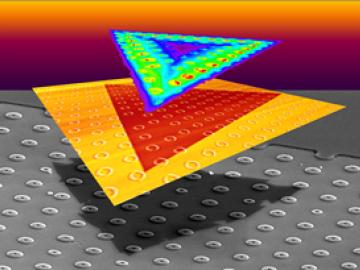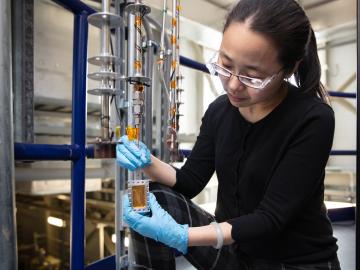
Filter News
Area of Research
- (-) Electricity and Smart Grid (3)
- (-) Fusion and Fission (5)
- (-) Materials (41)
- (-) Nuclear Science and Technology (5)
- Advanced Manufacturing (8)
- Biology and Environment (50)
- Building Technologies (2)
- Computational Engineering (2)
- Computer Science (10)
- Energy Science (120)
- Energy Sciences (1)
- Functional Materials for Energy (1)
- Fusion Energy (1)
- Materials for Computing (8)
- Mathematics (1)
- National Security (20)
- Neutron Science (14)
- Quantum information Science (9)
- Sensors and Controls (1)
- Supercomputing (47)
News Topics
- (-) Clean Water (3)
- (-) Composites (9)
- (-) Grid (8)
- (-) Machine Learning (5)
- (-) Molten Salt (7)
- (-) Quantum Science (11)
- 3-D Printing/Advanced Manufacturing (29)
- Advanced Reactors (20)
- Artificial Intelligence (10)
- Big Data (2)
- Bioenergy (12)
- Biology (5)
- Biomedical (9)
- Buildings (5)
- Chemical Sciences (34)
- Computer Science (21)
- Coronavirus (5)
- Critical Materials (13)
- Cybersecurity (5)
- Education (1)
- Energy Storage (35)
- Environment (18)
- Exascale Computing (3)
- Fossil Energy (1)
- Frontier (4)
- Fusion (35)
- High-Performance Computing (6)
- Irradiation (1)
- Isotopes (17)
- ITER (6)
- Materials (74)
- Materials Science (81)
- Mathematics (1)
- Microelectronics (1)
- Microscopy (27)
- Nanotechnology (39)
- National Security (3)
- Neutron Science (39)
- Nuclear Energy (74)
- Partnerships (13)
- Physics (31)
- Polymers (17)
- Quantum Computing (3)
- Security (4)
- Simulation (4)
- Space Exploration (8)
- Summit (2)
- Transportation (16)
Media Contacts

A new method developed at Oak Ridge National Laboratory improves the energy efficiency of a desalination process known as solar-thermal evaporation.

A team led by scientists at the Department of Energy’s Oak Ridge National Laboratory explored how atomically thin two-dimensional (2D) crystals can grow over 3D objects and how the curvature of those objects can stretch and strain the

OAK RIDGE, Tenn., May 7, 2019—Energy Secretary Rick Perry, Congressman Chuck Fleischmann and lab officials today broke ground on a multipurpose research facility that will provide state-of-the-art laboratory space

Researchers at the Department of Energy’s Oak Ridge National Laboratory, Pacific Northwest National Laboratory and Washington State University teamed up to investigate the complex dynamics of low-water liquids that challenge nuclear waste processing at federal cleanup sites.

Oak Ridge National Laboratory scientists analyzed more than 50 years of data showing puzzlingly inconsistent trends about corrosion of structural alloys in molten salts and found one factor mattered most—salt purity.

Oak Ridge National Laboratory scientists studying fuel cells as a potential alternative to internal combustion engines used sophisticated electron microscopy to investigate the benefits of replacing high-cost platinum with a lower cost, carbon-nitrogen-manganese-based catalyst.

Scientists at the Department of Energy’s Oak Ridge National Laboratory have created a recipe for a renewable 3D printing feedstock that could spur a profitable new use for an intractable biorefinery byproduct: lignin.

Scientists from Oak Ridge National Laboratory performed a corrosion test in a neutron radiation field to support the continued development of molten salt reactors.

Carbon fiber composites—lightweight and strong—are great structural materials for automobiles, aircraft and other transportation vehicles. They consist of a polymer matrix, such as epoxy, into which reinforcing carbon fibers have been embedded. Because of differences in the mecha...

Experts focused on the future of nuclear technology will gather at Oak Ridge National Laboratory for the fourth annual Molten Salt Reactor Workshop on October 3–4.


